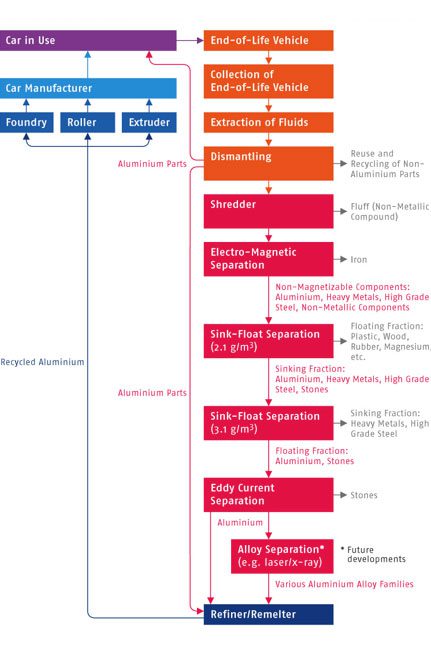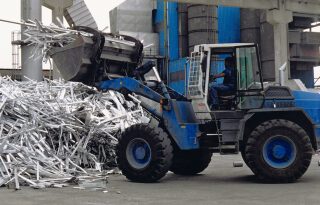The aluminium industry recycles all the aluminium scrap it can obtain.
Primary aluminium producers and the producers of semi-fabricated and fabricated products generally collect and recycle all of the aluminium scrap they generate (new scrap) and therefore the success of a recycling system depends on the degree to which used products are collected at the end of their lives. Collection rates vary depending on the product in question, waste management systems in place and on society’s understanding of the value of aluminium scrap and its commitment to conserve that value.
Globally, aluminium achieves among the highest material recycling rates for end of life products, with up to 90% for transport and construction applications. The metal’s economic scrap value and ability to be recycled continuously makes the aluminium beverage can the most recycled container in the world, with a global average recycling rate of 60% and a rate of over 90% in some countries.
The recycled product may be the same as the original product (e.g. window frame recycled back into a window frame or can to can), but is more often a completely different product (e.g. a cylinder head recycled into a gearbox).
Around 25% of aluminium produced every year is destined for the transportation sector, where it is used to reduce vehicle weight, improving safety and reduce greenhouse gas emissions by increasing fuel efficiency. In 2002 the average passenger car contained between 100 and 120 kg of aluminium, while in 2008 this figure had increased to between 110 and 140 kg.
At the end of a vehicle’s useful life some aluminium parts, such as wheels and cylinder heads, are removed and the remaining car body is fed into a shredder, after which the aluminium fraction is separated from ferrous alloys using magnets and from other materials through sink-float and eddy current processes or laser and spectroscopic technologies.
Mixed alloy aluminium scrap collected in this way is generally processed into casting alloys for the production of engines and gearboxes. Due to the increasing use of wrought alloys in car bodies, a growing volume of such scrap is anticipated and hence the separate collection of specific alloys from cars is likely to become economically viable in the future.
Aluminium used in other modes of transportation is collected in the same way, although the parts are often too large to be directly melted in the furnace and must first be cut to size. Most aluminium-containing ships and railway coaches are still in use, however, because of aluminium’s relatively recent history in these applications and because of the metal’s durability.
Recycling rates for end of life vehicles (ELV) average around 90% globally, with higher rat.

Aluminium’s formability, its high strength-to-weight ratio, corrosion resistance and ease of recycling, make it the ideal material for a wide range of building applications, from windows and doors to roofs and walls to air-conditioning systems and solar panels.
Today around 13 million tonnes of aluminium a year are used in construction, while it is estimated that globally some 220 million tonnes of aluminium are currently in use in buildings.
A building’s design, along with the behaviour of its users can have a very large impact on its environmental and energy performance. In a typical building, the use phase holds the majority of its energy requirements, while the materials and construction account for only a small fraction of the life cycle total. Choosing the right material for the right application is therefore critical in reducing all the energy requirements over the life cycle of the building.
The final phase of a building’s life needs to also be considered when making material choices. A large amount of waste building materials goes to landfill sites at a cost both to the economy and to the environment; other materials are recycled at cost to the community. In contrast, aluminium is recycled in a way that pays for itself and is sustainable.
A 2004 study by Delft University of Technology found that collection rates for aluminium in European buildings were between 92% and 98%. Professor Udo Boin noted in his report that “despite the aluminium content being below 1% of the total mass of the individual building, it represents a considerable volume for collection and sometimes the only real economic return from the entire demolition, thanks to the high intrinsic value of aluminium.
Globally, aluminium enjoys a high collection rate of around 85% from buildings at end of life. The industry is keen to increase collection rates and is working with producers of building applications to enable more efficient collection of scrap from demolished buildings and at end of service life.
Aluminium possesses unique barrier and physical properties and is therefore used extensively for the packaging of food, beverages and pharmaceuticals. Even in its thinnest form, aluminium effectively protects contents against the quality-reducing effects of oxygen, light, moisture, micro-organisms and unwanted aromas.
Generally, the energy required for the production of packaging is only a small percentage of the total energy used to produce and supply the final product. If the final product is spoiled due to inadequate packaging much more energy is wasted than needed to produce the packaging.
Two different types of packaging can be distinguished,:
- rigid and semi-rigid packaging, i.e. food and beverage cans, aerosol containers, closures and menu trays, and
- flexible packaging, i.e. packaging where a thin aluminium foil is laminated as a barrier material to plastics or cardboard.
For rigid and semi-rigid packaging, of which aluminium beverage cans make up the largest volume globally, techniques have been developed to recycle old scrap into ingots from which wrought products (e.g. can stock) can be fabricated. Such scrap has a high aluminium content and therefore a high market value.
The collection rate of used rigid and semi-rigid containers depends greatly upon individual national incentives, including deposit systems, voluntary prepaid recycling charges or advertising, and the efficiency of the collection schemes. In Europe the collection rate of all aluminium packaging is about 50%. The collection rates of used beverage cans vary from country to country from 30% to close to 100%, with a global average of close to 70%. Sweden and Switzerland collect 91% and 90% of their aluminium beverage cans, respectively. Sweden’s success lies in a deposit system whereas in Switzerland a voluntary prepaid recycling charge covers the costs of collection. Brazil is also one of the world leaders in can recycling, with a collection rate of 98%. Every region in Brazil has a recycling market which facilitates easy collection and transportation of end-of-life products. This has encouraged communities to collect and form co-operatives across the country. In Japan a collection rate for used beverage cans of 93% is achieved with a voluntary system. Collecting points include recycle boxes at supermarkets and major shopping centres, volunteer groups and municipality offices.
In flexible packaging, the aluminium barrier often has a low thickness and is typically laminated with paper and/or plastic layers that are the major components of the packaging. This means that flexible packaging waste has a very low aluminium content. Nevertheless, aluminium can be extracted from laminates by pyrolysis and thermal plasma techniques. Alternatively, such a packaging is incinerated with a recovery of the combustion heat. Because of its low thickness, the aluminium barrier will be oxidized completely, and the combustion heat of aluminium can be recovered. The question of whether incineration or recycling is environmentally feasible can only be decided case-by-case, while comparing the specific alternatives by life cycle assessments, taking specific local circumstances and other aspects of sustainability into consideration.
At the end of their useful life, if pre-treated and/or sorted, aluminium products can be recycled for use in almost all aluminium applications since the metal’s atomic structure is not altered during melting, meaning that the value of the material can be recovered without loss of quality.
